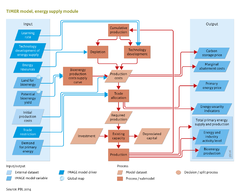Energy supply/Description: Difference between revisions
Jump to navigation
Jump to search
Oostenrijr (talk | contribs) No edit summary |
Oostenrijr (talk | contribs) m (Text replace - "N2O" to "N<sub>2</sub>O") |
||
| Line 65: | Line 65: | ||
* The trade and allocation of biofuel production to regions is determined by optimisation. An optimal mix of bio-solid and bio-liquid fuel supply across regions is calculated, using the prices of the previous time step to calculate the demand. | * The trade and allocation of biofuel production to regions is determined by optimisation. An optimal mix of bio-solid and bio-liquid fuel supply across regions is calculated, using the prices of the previous time step to calculate the demand. | ||
The production costs for bioenergy are represented by the costs of feedstock and conversion. Feedstock costs increase with actual production as a result of depletion, while conversion costs decrease with cumulative production as a result of ‘learning by doing’. Feedstock costs include the costs of land, labour and capital, while conversion costs include capital, {{abbrTemplate|O&M}} and energy use in this process. For both steps, the associated greenhouse gas emissions (related to deforestation, | The production costs for bioenergy are represented by the costs of feedstock and conversion. Feedstock costs increase with actual production as a result of depletion, while conversion costs decrease with cumulative production as a result of ‘learning by doing’. Feedstock costs include the costs of land, labour and capital, while conversion costs include capital, {{abbrTemplate|O&M}} and energy use in this process. For both steps, the associated greenhouse gas emissions (related to deforestation, N<sub>2</sub>O from fertilisers, energy) are estimated (see Component [[Emissions]]), and are subject to carbon tax, where relevant. | ||
===Other renewable energy=== | ===Other renewable energy=== | ||
Revision as of 10:36, 1 July 2014
Parts of Energy supply/Description
| Component is implemented in: |
|
| Related IMAGE components |
| Projects/Applications |
| Key publications |
| References |
